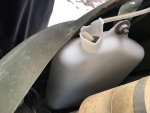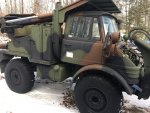Toolee
New member
- 16
- 0
- 1
- Location
- Washington
Field Mower on the SEE
I couldn't wait to weld up the brackets and hose management, so I put some tarp straps on it to hold the hoses from flopping and mowed the pasture, and it worked even better than I thought it would.

It has been rainy in the Puget Sound area lately so it was soft in spots, but I aired the XM47s down to 20 psi and it floated well and did not get stuck. It is pretty rough and hilly in places in this pasture, and it took quite a bit of adjusting to get the mower to stay the right height. You can see some spots where I dug in a bit with the nose of the mower and some bits of brush cut too high. I tried the float control but that was not helpful. Anybody tried adjusting the float level?
If you end up doing this, be sure you have a steering knob installed on the left spoke so you can keep the other hand on the loader controls. Also, I found it best to start in neutral, set the hand throttle at idle, let the clutch out easy and spin up the mower, then throttle up to about 1600 RPMs. Once the mower is going, put it in gear and start mowing. I ran it in compound low but if the pasture was level I could have gone up a gear or two. Corners were easy--the mower just sweeps across since it is so far out front and the SEE turns so tight. If you have to come up tight to a fence post, set the mower first, then spin it up and reverse away from the post. I had some 2-3 inch red alder about 6 feet tall that just disappeared chips-a-flyin' as I went over it and neither the mower nor SEE noticed it. No leaks, no overheating, no problems.
Here are some pics of the hose routing from behind the cab and where they come out in front:


That is 3/4 inch hose terminated in 12 JIC ends.
Here is a view of the same spots with enough attached to run the mower:


The valves only supply the hydraulics to the front so far, and I still need to add a bracket to attach them. I don't necessarily like the location in the front--leaves things vulnerable--think I will be changing that. The connectors are all 3/4 inch flush face with female NPT connections--I used 3/4 NPT x 12 JIC adapters to attach to the hose. I found the 45 degree adapters to be useful at both ends.
I'll post more as I button things up.
I couldn't wait to weld up the brackets and hose management, so I put some tarp straps on it to hold the hoses from flopping and mowed the pasture, and it worked even better than I thought it would.

It has been rainy in the Puget Sound area lately so it was soft in spots, but I aired the XM47s down to 20 psi and it floated well and did not get stuck. It is pretty rough and hilly in places in this pasture, and it took quite a bit of adjusting to get the mower to stay the right height. You can see some spots where I dug in a bit with the nose of the mower and some bits of brush cut too high. I tried the float control but that was not helpful. Anybody tried adjusting the float level?
If you end up doing this, be sure you have a steering knob installed on the left spoke so you can keep the other hand on the loader controls. Also, I found it best to start in neutral, set the hand throttle at idle, let the clutch out easy and spin up the mower, then throttle up to about 1600 RPMs. Once the mower is going, put it in gear and start mowing. I ran it in compound low but if the pasture was level I could have gone up a gear or two. Corners were easy--the mower just sweeps across since it is so far out front and the SEE turns so tight. If you have to come up tight to a fence post, set the mower first, then spin it up and reverse away from the post. I had some 2-3 inch red alder about 6 feet tall that just disappeared chips-a-flyin' as I went over it and neither the mower nor SEE noticed it. No leaks, no overheating, no problems.
Here are some pics of the hose routing from behind the cab and where they come out in front:


That is 3/4 inch hose terminated in 12 JIC ends.
Here is a view of the same spots with enough attached to run the mower:


The valves only supply the hydraulics to the front so far, and I still need to add a bracket to attach them. I don't necessarily like the location in the front--leaves things vulnerable--think I will be changing that. The connectors are all 3/4 inch flush face with female NPT connections--I used 3/4 NPT x 12 JIC adapters to attach to the hose. I found the 45 degree adapters to be useful at both ends.
I'll post more as I button things up.
Last edited:




